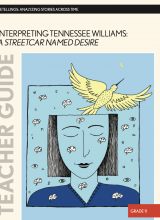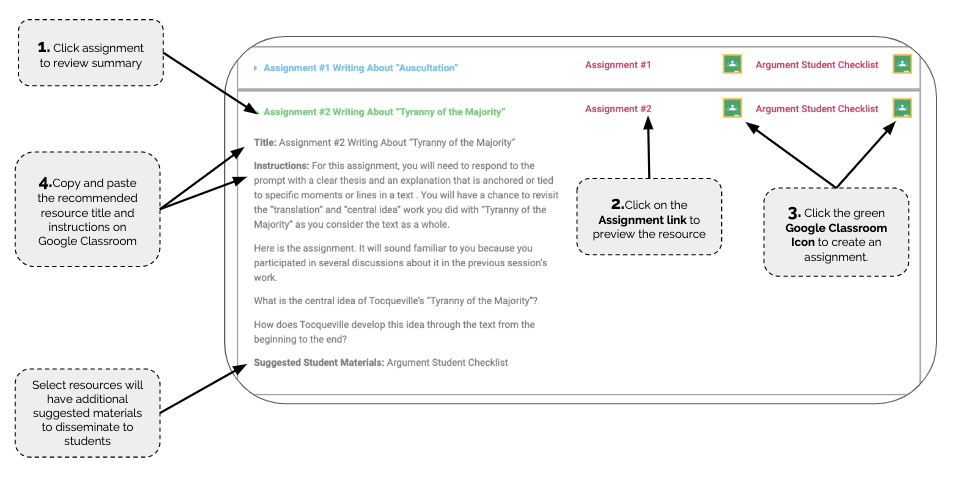Interpreting Tennessee Williams:
A Streetcar Named Desire - Grade 11
In this study, students will work closely with Tennessee Williams’ play A Streetcar Named Desire. There are two primary goals in this unit: First, to provide students with a close encounter—marked by complete cycles of comprehension and interpretive work—with a major American play. At the end of the unit, students will be familiar with the story, and they will have participated in a round of interpretive work designed to deepen their understanding of the play. Second, students will have an opportunity to think about the work of interpreting a “source text” like Williams’ play.

Table of Contents
Writing Tasks
Title: Tracking Kazan’s A Streetcar Named Desire
Teacher Manual Instructions:
Session 1-5
The first five sessions of this study are set aside for viewing Elia Kazan’s film adaptation of Tennessee Williams’ A Streetcar Named Desire. Williams’ play eschews a more traditional act/scene structure and is divided instead into 11 scenes. We recommend that students use the “Tracking Kazan’s A Streetcar Named Desire” sheet to monitor and record information about each individual scene. Alternatively, students could recreate versions of the form for each scene in their notebooks. In either case, by the end of the film, students should have filled out 11 tracking sheets—one for each of the 11 scenes in the play.
Title: The First Interpretive Assignment Writing About Kazan’s A Streetcar Named Desire
Teacher Manual Instructions:
Session 7
Suggested Student Materials: Interpretive_Argument Checklist
Title:The Final Interpretive Assignment Comparing Kazan and Jordan
Teacher Manual Instructions:
Session 12
Suggested Student Materials: Interpretive_Argument Checklist
Charts for Discussion
Checks for Understanding
Title: Whole-Class Summary
Teacher Manual Instructions:
Session 6
When the gallery walk is over, reconvene the whole group. Tell students that they will now work as a class to compete the main task of this session: Crafting a summary of the whole play.
Ask students to take a moment to review all 11 scene summary charts in order. Suggest that, as they skim through the charts, students look for ways to further condense the information on each chart. It is worth taking a moment to ask students to share anything that stood out to them as they reviewed the script for their scene: Were there differences that they noticed? Were there lines that seemed especially important while reviewing the text? What did they under- stand more clearly after reading the script?
Next, collaborate as a class to create a whole-class summary of the play that you capture on the board or a chart. To do this, ask for a volunteer or two to summarize the first scene of the play using a single sentence, or, if need be, two. Follow the same process with the next scene. After you have four or five sentences down, go back and ask volunteers for suggestions about how you could further condense the text you’ve drafted by combining sentences, taking out extraneous information, etc.
Title: Scene 3: Kazan vs. Jordan
Teacher Manual Instructions:
Session 10
Give students 2-3 minutes to review their notes, independently, looking carefully at the choices in one scene that make it so different from the other. (For example, “In Kazan’s scene, it’s like this. In Jordan’s, it’s like that.”)
Reconvene the whole class. Facilitate a brief discussion about the different choices each director made in their film versions of the scene. Capture this comparison on a two-column chart titled something like “Scene 3: Kazan vs. Jordan.” Use the left column for Kazan’s choices and the right for Jordan’s. The intention here is to help clarify and firm up the class’s sense of how Kazan’s and Jordan’s scenes are similar and different.
Title: Kazan’s Choices: Effects
Teacher Manual Instructions:
Session 11
In addition to facilitating this conversation, work hard to capture and distill the major claims students seem to be making. Capture these claims on two charts, one for each film. Title these charts something like “Kazan’s Choices: Effects” and “Jordan’s Choices: Effects.” Push students to generate film- and script-based evidence to illustrate and support each entry.
Title: Jordan’s Choices: Effects
Teacher Manual Instructions:
Session 11
Independent Reading
Title: Book Interview
Instructions:
Display a copy of the “Book Interview” sheet for the class to see and distribute copies to students.
Using one of the books from the classroom library, model for students how to interview a book and how to fill out the sheet. Answer any questions students have about the form and its terminology.
Give students time to interview three books and to enter their findings on the “Book Interview” sheet.
Title: Book Pass
Instructions:
Organize students’ desks into a circle (or, if this is not possible, determine a very clear path for books to pass through the group).
Explain the purpose of a book pass:
A book pass is another way to expose students to the texts available in the classroom library. A book pass requires students to use their book interviewing skills. A book pass is a chance for students to find titles to add to their “Books I’d Like to Read” list.
Display a copy of the “Book Pass” for the class to see and pass out copies to students.
Demonstrate for the class how a person goes about making an entry on the form. Since students will need to write quickly, show how an author can be listed just by last name and first initial, and demonstrate how a student can abbreviate a long title if necessary. What matters is that they have enough information to track down the book again later if they need to.
Give each student one book (or magazine). Tell them it doesn’t matter which text they start with, because they will see all—or at least many of—the books. (Be sure you have one title for each student in the circle.)
Choose a direction for passing.
After students receive a book, they should immediately record the author’s name (if the text is a book) and title on the “Book Pass” form.
Give students one minute to interview each book following the procedure established in the previous session.
At the end of one minute, call “pass.” At this time, students should make an entry in the comments column and pass the book to the next student.
Continue the book pass until each student has interviewed all the books.
Title: Book Recommendation
Instructions:
Distribute copies of the “Book Recommendation” form to students and give them time to craft or begin crafting their first review. Students can choose to write about a book they’ve completed recently or one they remember well from past reading.
Title: Goals for My Reading Life
Instructions:
Display a copy of “Goals for My Reading Life” for the class to see and distribute copies to students.
Use this time to review how to fill out the goals sheet. Be sure to show students how they can use the charts to generate ideas for answers to the “Goals” questions.
Take a moment to stress the value and function of the “Books I’d Like to Read” list. Point out that this list is a tool that serves the same function as a bedside table for some readers: It is a place to store up titles or books that are “next in line.” Remind the class that readers constantly have their eyes open for “next” texts. A “Books I’d Like to Read List” is a way to prevent aimless and unproductive castings around for new reading materials. It’s a planning tool.
Explain that at the beginning of each marking period, each student will fill out a new goals sheet; at at the end of each marking period, students will take a few minutes to review their goals statements and reflect on their efforts to meet them.
Answer any questions students have about the “Goals for My Reading Life” forms.
Give students time to complete the form and set a deadline for submission. You may decide to photocopy these to keep a set for yourself. Return the forms to students during the next session and have them attach the form to a page in their notebook or save it for their student portfolio (see Creating a Student Portfolio).
Title: Reading Log
Teacher Manual Instructions:
Show students how to set up a “Reading Log” in their notebook. They should be sure to enter it in their table of contents. You may decide to distribute sticky notes so that students can flag this page. Use the model on the next page to guide your efforts.
Notice the column titled “Date Completed/# of Pages Read.” This column is a place for students to record, and receive credit for, the reading of texts that did not require a “cover-to-cover” experience. Be sure to point out that reading sections of several texts for specific purposes is not the same as skipping aimlessly from book to book to book. The former often indicates purposefulness and interest; the latter can indicate confusion or disengagement.
After students have set up the reading log—including proper headings, creating the grid, etc.—demonstrate how to make an entry.
Answer any questions students have about the log.
Remind students that the reading log is a tool to be used in conjunction with the “Goals” sheets. Students track their reading in the log and then use the log to evaluate their progress toward their goals.
If you plan to use student portfolios this year, consider introducing them at this time using some version of the information in the section that follows. Review Creating a Student Portfolio in advance to be sure you have thought through some of the important questions for portfolio work.
Unit Resources
Title: The First Interpretive Assignment: Writing About Kazan’s A Streetcar Named Desire
Title: The Final Interpretive Assignment: Comparing Kazan and Jordan
Title: Grades 11 and 12 – Interpretive_Argument Rubric
Title: Grades 11 and 12 – Informational_Explanatory Rubric
Title: Scaffolds and Modifications: Descriptions and Use
